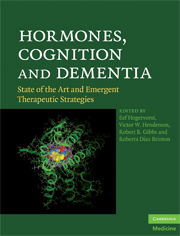Book contents
- Hormones, Cognition and Dementia
- Hormones, Cognition and Dementia
- Copyright page
- Contents
- Contributors
- Preface
- Section 1 Estrogens and cognition: perspectives and opportunities in the wake of the Women's Health Initiative Memory Study
- Section 2 Varieties of estrogenic therapy
- Section 3 Potential modulators and modifiers of estrogenic effects
- Section 4 Possible genetic factors related to hormone treatment effects
- Section 5 Testosterone, estradiol and men, and sex hormone binding globulin
- Section 6 Gonadotropin effects
- Chapter 26 Involvement of gonadotropins in cognitive function: implications for Alzheimer's disease
- Chapter 27 The role of gonadotropins and testosterone in the regulation of beta-amyloid metabolism
- Chapter 28 Epilogue
- Chapter 29 Concluding remarks
- Index
- Plate Section
Chapter 27 - The role of gonadotropins and testosterone in the regulation of beta-amyloid metabolism
from Section 6 - Gonadotropin effects
Published online by Cambridge University Press: 06 July 2010
- Hormones, Cognition and Dementia
- Hormones, Cognition and Dementia
- Copyright page
- Contents
- Contributors
- Preface
- Section 1 Estrogens and cognition: perspectives and opportunities in the wake of the Women's Health Initiative Memory Study
- Section 2 Varieties of estrogenic therapy
- Section 3 Potential modulators and modifiers of estrogenic effects
- Section 4 Possible genetic factors related to hormone treatment effects
- Section 5 Testosterone, estradiol and men, and sex hormone binding globulin
- Section 6 Gonadotropin effects
- Chapter 26 Involvement of gonadotropins in cognitive function: implications for Alzheimer's disease
- Chapter 27 The role of gonadotropins and testosterone in the regulation of beta-amyloid metabolism
- Chapter 28 Epilogue
- Chapter 29 Concluding remarks
- Index
- Plate Section
Summary
Verdile and Martins review the relationship between dysfunction of the hypothalamic-pituitary-gonadal (HPG) axis, reduced levels of testosterone in men, cognitive decline, and risk of Alzheimer's disease (AD). Regulation of testosterone and luteinizing hormone (LH) are tightly linked, and following reproductive senescence declines in sex hormones are coupled with elevated gonadotropin levels. Several studies have reported that compared to controls, men with AD and other dementias have lower serum testosterone levels. Testosterone has been shown to have a number of neuroprotective effects, including reducing oxidative stress and inflammatory processes, which are key events in the AD brain. While animal and in vitro analyses have provided support for the therapeutic potential of testosterone, definitive benefits of testosterone therapy remain to be determined. The APOE ε4 allele appears to be a determining factor in the association between testosterone and the risk of developing dementia in men. It appears that both testosterone and LH can impact beta-amyloid accumulation and AD pathogenesis, although the relative contributions of each hormone remain undefined. Verdile and Martins propose that combinational hormone therapy (HT) may prove to be more efficacious in the prevention of AD.
- Type
- Chapter
- Information
- Hormones, Cognition and DementiaState of the Art and Emergent Therapeutic Strategies, pp. 259 - 268Publisher: Cambridge University PressPrint publication year: 2009



